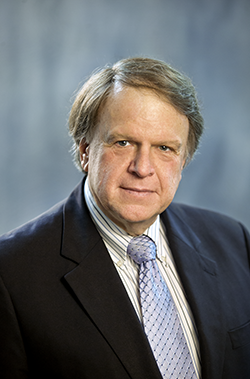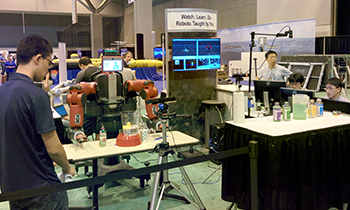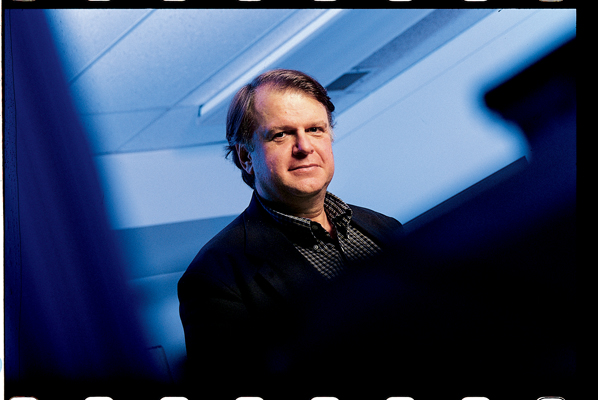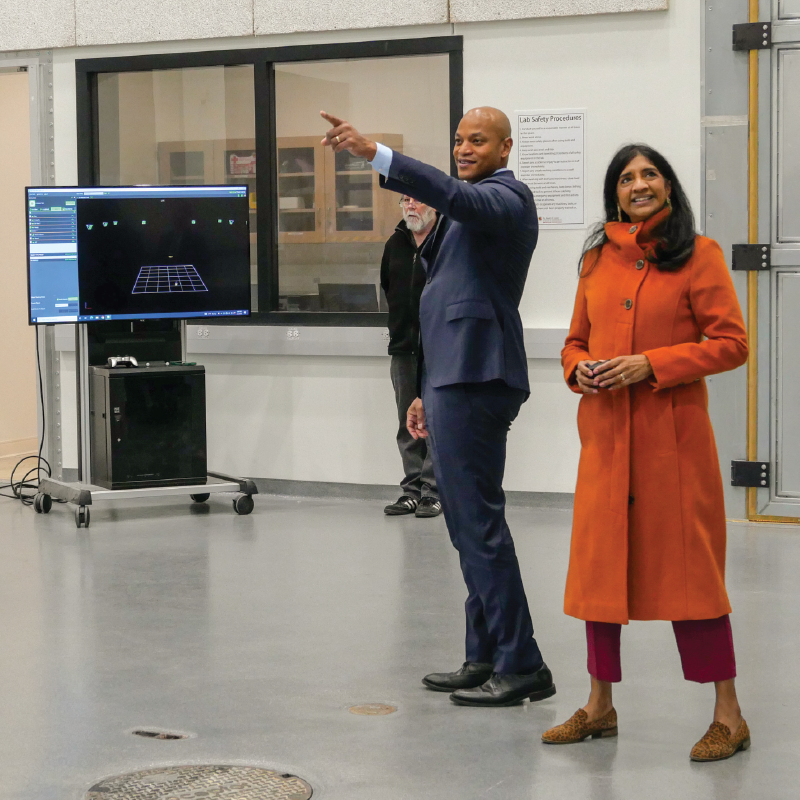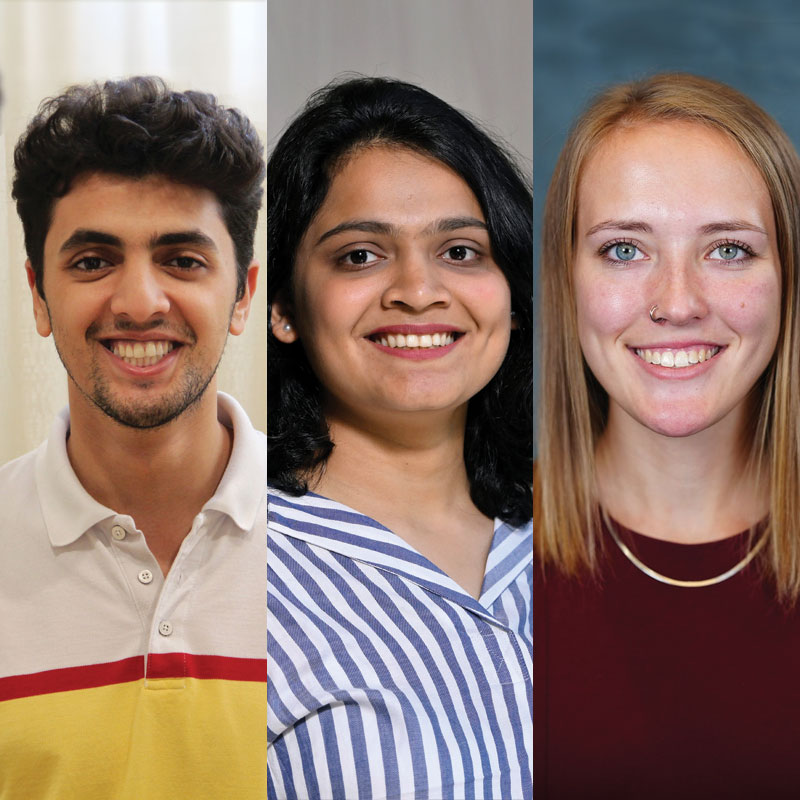News Story
John S. Baras inducted into Clark School Innovation Hall of Fame

The A. James Clark School of Engineering inducted Professor John S. Baras (ECE/ISR) into its Innovation Hall of Fame in a ceremony on Oct. 24. Baras created algorithms and protocols by which Internet services can be delivered over satellite, beginning [1–4] with the introduction and demonstration (Fig. 1) of the first working broadband Internet over satellite protocol in 1994. When the new Internet over satellite technology was introduced in 1994, it was much faster than the fastest available broadband for consumers: 480 kbps vs. 96 kbps terrestrial.
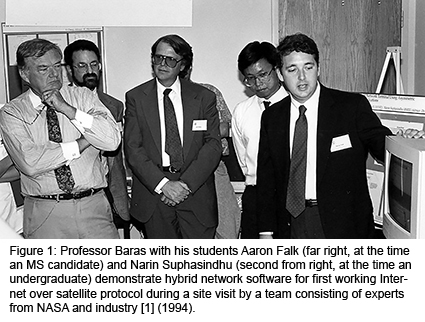
Baras’ research was performed under the Center for Satellite and Hybrid Communication Networks (CSHCN), which Baras co-founded with his colleague Anthony Ephremides in 1992. CSHCN (now HyNet—the Maryland Hybrid Networks Center) began as a NASA Center for the Commercial Development of Space, with the vision that the success and long-term viability of the communications satellite industry would require efficient integration of satellite technology into terrestrial networks, resulting in hybrid networks (integrated interoperable satellite and terrestrial networks (Fig. 2).
Since he foresaw the explosion in Internet use over communication networks of all types, Baras focused his CSHCN (and later HyNet) work on the key challenge of developing broadband Internet over hybrid networks. John Baras’ specific initial solution [1–4] emerged from the framework of his joint work with Anthony Ephremides and their students, which was recognized by an Outstanding Invention of the Year Award from the Office of Technology Liaison of the University of Maryland in 1994 [5]. The specific initial Internet over satellite protocol, developed by Baras, consisted of a request for Internet service sent using a telephone connection to a satellite gateway with the response coming from the satellite directly to the home or office using the new protocol (Fig. 3). Baras’ initial innovation [1–4] involved (Fig. 4): (i) “splitting the connection”; (ii) “address spoofing”; and (iii) “selective acknowledgment.” Combined, these three elements informed the TCP protocol that the delay in receiving an acknowledgment of a request back at the receiver was actually due to the satellite physical path delay and not due to congestion (which the TCP protocol is designed to assume).


To ensure that Internet over satellite technology would remain a competitive alternative to terrestrial Internet technologies, and to overcome the limitations of the initial asymmetric design (especially reliance on telephone companies), Baras continued this research effort [6–27] in the ensuing years (1993–present). He aimed to develop new two-way Internet over satellite protocols with faster service and with a guarantee of security. With his students, he obtained transformational research results, developed and tested prototypes, and worked closely with industry to commercialize Internet over satellite protocols and services [6–27].
 Several important innovations were developed and patents were granted over the years (the most recent in 2013), targeting such issues as: fast Internet service to broadband wireless LANs connected to a satellite via their hubs; efficient Internet multicasting schemes over hybrid networks; efficient and adaptive hybrid (multicast and unicast) data delivery systems; secure and scalable two-way broadband satellite Internet services; provision of mobile wireless telephone services to rural and underdeveloped areas; acceleration schemes for broadband two-way satellite Internet services; Layered Encryption Security (LES) resulting in the Layered IPSEC International Standard; new lightweight symmetric-key digital certificates (extended TESLA certificates) and a source authentication protocol for group communication in hybrid wireless-satellite networks (much less expensive in terms of processing power and energy of the smart devices, compared to digital signatures); innovations on security of satellite Internet services; and extensions to space communications, including Internet service to planes, to the International Space Station (ISS) (Fig. 5) and communications between Earth and expedition teams on the moon.
Several important innovations were developed and patents were granted over the years (the most recent in 2013), targeting such issues as: fast Internet service to broadband wireless LANs connected to a satellite via their hubs; efficient Internet multicasting schemes over hybrid networks; efficient and adaptive hybrid (multicast and unicast) data delivery systems; secure and scalable two-way broadband satellite Internet services; provision of mobile wireless telephone services to rural and underdeveloped areas; acceleration schemes for broadband two-way satellite Internet services; Layered Encryption Security (LES) resulting in the Layered IPSEC International Standard; new lightweight symmetric-key digital certificates (extended TESLA certificates) and a source authentication protocol for group communication in hybrid wireless-satellite networks (much less expensive in terms of processing power and energy of the smart devices, compared to digital signatures); innovations on security of satellite Internet services; and extensions to space communications, including Internet service to planes, to the International Space Station (ISS) (Fig. 5) and communications between Earth and expedition teams on the moon.
Baras’ results were implemented progressively over time, in a long-term (1993–2004), extremely successful collaboration with Hughes Network Systems (HNS) engineers in several HNS award winning products (Turbo Internet, DirecPC, DirecDuo, DirecWay) culminating with HughesNet®, which became the company’s largest single business. In 2012, at the 25th Anniversary Maryland Industrial Partnerships Program (MIPS) Awards [28], Baras received the Principal Investigator with Greatest Impact Award for this work, and shared with HNS the Award for the Largest Selling Product (HughesNet®) ever developed with MIPS support.
Baras’ many contributions and innovations made possible widespread and inexpensive Internet connectivity via satellite and other broadband wireless networks, at high data rates reaching tens and hundreds of Mbps. They were essential to the creation of the industry sector for Internet services over satellite, serving consumers, businesses, ships and aircraft, remote oil rigs, military networks, and facilitating Internet connectivity to rural and underdeveloped areas, telemedicine services, environmental information, and emergency and disaster relief. Today many companies provide such services and products, including iDirect, ViaSat, Gilat, News Data Service Corporation, Astra, Eutelsat, and Bentley Walker, with billions of dollars in sales, tens of millions of users and broad societal impact. Recently, satellite-based broadband Internet to planes has received much attention from airlines and the FCC, with the deployment of in-flight satellite-based Internet service (starting with Boeing Connexion in 2001–2002).
John Kenyon, Senior Vice President Hughes Network Systems said, “He and his students developed, implemented and tested the first ever broadband Internet over satellite protocol. It was this initial solution that was commercialized in collaboration with Hughes Network Systems engineers into the award winning products Turbo Internet and DirecPC -- the first commercial satellite broadband service in the world. Subsequently, they collaborated with Hughes Network Systems engineers to develop two-way Internet over satellite protocols for the DirecWay satellite broadband service. This foundational work along with many innovations in VSAT technology by HNS and others became part of what is now a multibillion dollar industry serving tens of millions of users, with applications still increasing today in many sectors, such as consumers, businesses, ships, aircraft, remote oil rigs, healthcare, defense, and disaster relief.”
Baras involved many graduate and undergraduate students in this research over the years. He graduated 22 M.S. and 11 Ph.D. students whose work was focused on the theme of Internet over satellite, all of whom joined the industry upon graduation.
John Baras holds the Lockheed Martin Chair in Systems Engineering, was the founding director of the Institute for Systems Research and the co-founding director along with Ephremides of the Maryland Hybrid Networks (HyNet) Center. Baras is a Foreign Member of the Royal Swedish Academy of Engineering Sciences, and a Fellow of IEEE, SIAM, AAAS, NAI and IFAC.
References
[1] “Hughes Announces DirecPC(TM) Developed with ISR Device Driver,” Syst. Signals, Institute for Systems Research, Univ. of Maryland, College Park, 1994, http://tinyurl.com/d4pezw5.
[2] A. Falk, N. Suphasindhu, D. Dillon and J.S. Baras, “A System Design for a Hybrid Network Terminal Using Asymmetric TCP/IP to Support Internet Applications,” Proc. Technology 2004 Conference, Washington, D.C., Nov. 8-10, 1994.
[3] A. Falk, A System Design for a Hybrid Network Data Communications Terminal Using Asymmetric TCP/IP to Support Internet Applications, M.S. Thesis, Systems Engineering, University of Maryland, Spring 1994.
[4] V. Arora, J.S. Baras, A. Falk, D. Dillon and N. Suphasindhu, “Hybrid Internet Access,” Proc. 12th Symposium on Space Nuclear Power and Propulsion/Commercialization, pp. 69-74, Albuquerque, New Mexico, January 8-12, 1995.
[5] J.S. Baras, A. Falk, D. Dillon, A. Ephremides, D. Friedman, N. Suphasindhu, B. Johnson, T. Kirkwoood, “A System Design for a Hybrid Network Data Communications Terminal Using Asymmetric TCP/IP to Support Internet Applications,” an Outstanding Invention of the Year Award for 1994, Office of Technology Liaison, University of Maryland, April 1995.
[6] V. Arora, N. Suphasindhu, J.S. Baras and D. Dillon, “Effective Extensions of Internet in Hybrid Satellite-Terrestrial Networks,” Proc. 1st Conference on the Commercial Development of Space, Part One, pp. 339-344, Albuquerque, New Mexico, Jan. 7-11, 1996.
[7] V. Arora, N. Suphasindhu, J.S. Baras and D. Dillon, “Asymmetric Internet Access Over Satellite-Terrestrial Networks,” Proceedings of the 16th AIAA International Communications Satellite Systems Conference and Exhibit, Part 1, pp. 476-482, Washington, D.C., Feb. 25-29, 1996.
[8] J.S. Baras, K. Holleman, M. Karir, V. Bharadwaj, S. Papademetriou and N. Suphasindhu “Extensions of DBS and Hybrid Internet,” Proc. 2nd ACM International Workshop on Satellite-Based Information Services, pp. 67-74, Budapest, Hungary, October 1, 1997.
[9] J.S. Baras, M.S. Corson, S. Papademetriou, I. Secka, and N. Suphasindhu, “Fast Asymmetric Internet Over Wireless Satellite-Terrestrial Networks,” Proc. 1997 IEEE Military Communications Conference (MILCOM), Vol. 1, pp. 372-377, Monterey, Calif., Nov. 2-5, 1997.
[10] J. S. Baras and I. Secka, “High Performance IP Multicasting Over Wireless Satellite-Terrestrial Networks,” Proc. 17th AIAA International Communications Satellite Systems Conf. & Exhibit, pp. 718-730, Yokohama, Japan, Feb. 24-26, 1998.
[11] V.G. Bharadwaj, J.S. Baras and N.P. Butts, “An Architecture for Internet Service via Broadband Satellite Networks,” Intern. J. of Satellite Communications, Vol. 19 (1), pp. 29-50, Jan. 2001.
[12] K. Stathatos, N. Roussopoulos and J.S. Baras, “Adaptive Data Broadcasting Using Air-Cache,” Proc. 1st Intern. Workshop on Satellite-based Information Services, pp. 30-37, Nov. 13, 1996.
[13] K. Stathatos, N. Roussopoulos and J.S. Baras, “Adaptive Data Broadcast in Hybrid Networks,” Proc. 23rd Intern. Conference on Very Large Databases, pp. 326-335, Athens, Aug. 1997.
[14] A. T. Nguyen, M. Hadjitheodosiou and J. S. Baras, “Alternative Network Architectures for Supporting Communications From the International Space Station,” 20th AIAA International Communication Satellite Systems Conference and Exhibit, pp. 1-10, Quebec, May 12-15, 2002.
[15] G. Akkor, M. Hadjitheodosiou and J. S. Baras, “Transport Protocols in Multicast via Satellite,” Intern. J. of Satellite Communication, Vol. 22, No. 6, pp. 611-627, Nov. 1 – Dec. 1, 2004
[16] X. Zhou and J.S. Baras, Patent Number: 7,827,459, “Communications Protocol,” awarded November 2, 2010.
[17] M. Karir and J. S. Baras, “LES: Layered Encryption Security,” Proceedings of the 3rd International Conference on Networking, pp. 382-388, Gosier, Guadeloupe, French Caribbean, February 29 – March 4, 2004.
[18] A. T. Nguyen, M. Hadjitheodosiou and J. S. Baras, “Broadband Communication Support for Earth Observation from the International Space Station,” Computer Networks Journal, Vol. 46, Issue 3, pp. 375-388, October 2004.
[19] Y. Shang, M. Hadjitheodosiou and J. S. Baras, “AeroTCP: A Splitting Transport Protocol for an IP-based Satellite Network Supporting Aeronautical Communications,” Proceedings AIAA 23 ICSSC Conference, Rome, Italy, September 25-28, 2005.
[20] A. Roy-Chowdhury, J. S. Baras, M. Hadjitheodosiou and S. Papademetriou, “Security Issues in Hybrid Networks with a Satellite Component,” IEEE Wireless Communications Magazine, pp. 50-61, December 2005.
[21] H. Zeng, A. Roy-Chowdhury, N. Rentz, M. Hadjitheodosiou and J. S. Baras, “Flexible and Dynamic Communication Architecture for Lunar Exploration,” Proceedings 24th AIAA International Communications Satellite Systems Conference, an Diego, CA, June 11-14, 2006.
[22] A. Roy-Chowdhury and J. S. Baras, “A Lightweight Certificate-based Source Authentication Protocol for Group Communications in Hybrid Wireless/Satellite Networks”, Proc. IEEE Global Communications Conference (Globecom 2008), New Orleans, LA, Nov. 30 – Dec. 4, 2008.
[23] A. Roy-Chowdhury and J. S. Baras, “Performance-Aware Security of Unicast Communication in Hybrid Satellite Networks,” Proceedings IEEE ICC 2009 Communication and Information Systems Security Symposium, pp.1-6, Dresden, Germany, June 14-18, 2009.
[24] A. Roy-Chowdhury and J. S. Baras, “Energy-efficient Source Authentication for Secure Group Communication with Low-Powered Smart Devices in Hybrid Wireless/Satellite Networks,” EURASIP J. on Wireless Communications and Networking, Special Issue on Security and Resilience for Smart Devices and Applications, vol. 2011, Article ID 392529, 18 pages, 2011.
[25] A. Roy-Chowdhury and J. S. Baras, “Probabilistic Non-Repudiation for Source Authentication with TESLA Certificates in Hybrid Satellite/Wireless and Performance Analysis of the Authentication Protocol,” Proc. Ka and Broadband Comm. Conference, Sept. 23-25, 2009.
[26] S. Perumal and J. S. Baras, "Performance Evaluation of Hybrid SAMA VSAT with FMCSA and Reservation," Proceedings 18th Ka and Broadband Communications, Navigation and Earth Observation Conference, Ottawa, Canada, September 24–27, 2012.
[27] A. Roy-Chowdhury and J. S. Baras, Patent Number: 8,397,062 B2, “Method and System for Source Authentication in Group Communications,” awarded March 13, 2013.
[28] MIPS 25th Anniversary Gala and Impact Awards, Nov 7, 2012, http://mips.umd.edu/25th/awards.html, Baras’ Awards are described in pages 9 and 10 of the Commemorative Book http://dl.dropbox.com/u/1392738/mips_25th_anniversary_book_lowres.pdf
Published October 11, 2016


